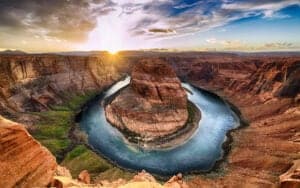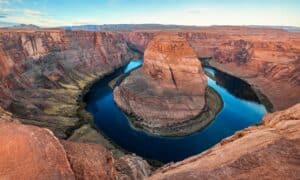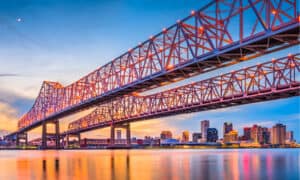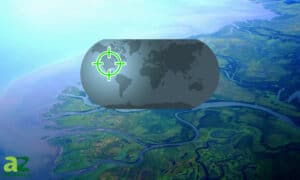How Long is the Delaware River?
The Delaware River is the longest river without dams east of the Mississippi!
The entire river serves as an interstate boundary. In other words, when you stand on one of the banks, you’ll always be looking across at a different state.
The immense river supports world-class trout fishery and river-based recreation. Economically, millions of people rely on the river to provide them with clean drinking water.
In addition, a wealth of wildlife also depends on the river to live. The working river is proud to be included in the National Wild and Scenic River system.
How long is the Delaware river? Read on to find out!
How Long Is the Delaware River?

vm2002/Shutterstock.com
The Delaware River is 330 miles long. Meanwhile, it’s only a little bit longer than the Hudson River, which is 315 miles long. The river serves as a major river on the Atlantic Coast of the United States.
Amazingly, the entire drainage area covers over 13,000 square miles. It’s eone of 19 “Great Waters” acknowledged by America’s Great Waters Coalition.
In addition, even though the river is large, it’s not the biggest in the area. Delaware is shorter than the Potomac (405 miles) and the Susquehanna Rivers (444 miles).
Where Does the Delaware River Start?
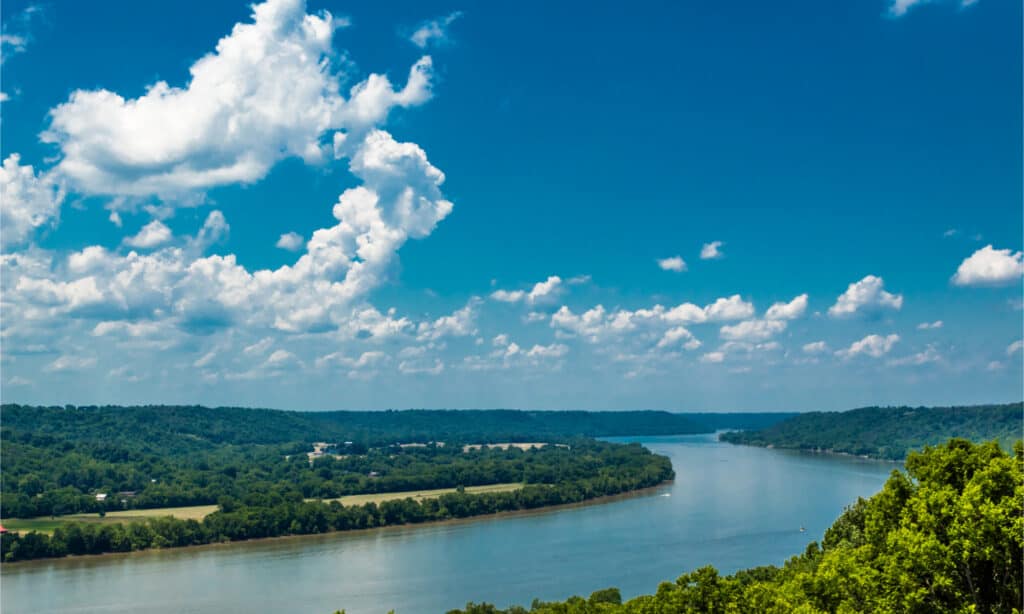
Corey B Stevens/Shutterstock.com
The Delaware River begins in the Catskill Mountains of New York. The river has 2 distinct branches.
Near Mount, Jefferson is where the Western branch of the river begins. Furthermore, the Eastern branch of the river also begins near Roxbury, located at Grand gorge.
Moving on, the Western and Eastern branches of the river merge in Hancock, New York. From there, they flow as 1 river down into the Delaware Bay.
As a result, the river flows through 5 States. The States include Pennsylvania, New York, Maryland, New Jersey, and Delaware. Pennsylvania is especially popular for its trout and bass fishing opportunities.
Where Does the Delaware River End?
The Delaware River ends when it enters the Atlantic Ocean. The river flows into the Atlantic Ocean right by Cape May in New Jersey. It also enters Cape Henlopen in Delaware.
How Deep Is the Delaware River?
The Delaware River is 113 ft deep in some parts. The deepest part of the river occurs at Big Eddy in Narrowsburg, New York. The depth of the river varies from one location to the next.
Regularly, the river has a depth of 4-6 feet along the shorelines. However, there’s a deep drop-off as you move away from the shore. Moving further out, the river reaches depths of 30 to 40 ft and beyond.
Deepening Project
The main transportation port for the Delaware River is a 103-mile stretch. The stretch occurs from Philadelphia and Camden to Delaware Bay. Fun fact; the large Delaware Bay isn’t the biggest bay in the world.
The main transportation port used to be a part of a decades-long deepening project. The project worked to change the river’s depth from 40 ft to 45 ft. Wrapping up in 2018, the project’s goal was able to help improve the route for shipping cargo.
Why Is the Delaware River So Famous?

Delaware is rich in lakes, rivers, and estuaries. What makes the Delaware river so famous?
The river is famous because George Washington crossed it on December 25th, 1776. As a general for the Continental Army, George Washington bravely led troops across the ice-filled river.
Moving forward, the journey was to aid in an attack against Hessian troops near Trenton. The crossing took place at Micani’s Ferry in Bucks County, Pennsylvania. The Delaware crossing cemented Washington’s role as a primary leader. Equally important, the river also helped shape the history of the States it runs through.
Delawares Main Tributaries
The Delaware River has over 200 tributary streams and creeks. There are around 14,000 miles of creeks and streams in the river watershed.
Each state has its major tributaries. The main tributaries in New York are the Neversink Mongaup Rivers and Callicoon Creek.
The Lackawaxen, Schuylkill, and Lehigh Rivers feed Delaware in Pennsylvania. Entering New Jersey, the main tributaries are the Cooper and Maurice Rivers, along with the Rancocas and Musconetcong Creek. The watersheds, streams, creeks, and rivers include Maurice River, Oldmans Creek, Salem river, and Valley Creek, to name a few.
Where Is the Delaware River Tidal?
The Delaware River is tidal from Trenton to Delaware Bay. From Trenton, New Jersey, to New York, the river is non-tidal. The 200-mile stretch of non-tidal waters is known for being exceptionally clean and high-quality.
Alternatively, the tidal portion of the river is also known as the Delaware estuary. It’s where the river’s freshwaters begin mixing with the ocean’s saltwater. The tidal change is around 6 ft in Delaware bay. In Trenton, New Jersey, the tidal changes around 10 ft.
Where Does the Delaware River Become Brackish?
The Delaware River is brackish in Wilmington, Delaware. In other words, the entire tidal portion of the river is estuarine.
Brackish waters are a mixture of salt and freshwater’s joining together. The salinity levels fluctuate. That’s why you’ll find saltwater in Delaware Bay. Alternatively, it’s primarily freshwater in Trenton, New Jersey.
Intriguing Delaware Bay Facts
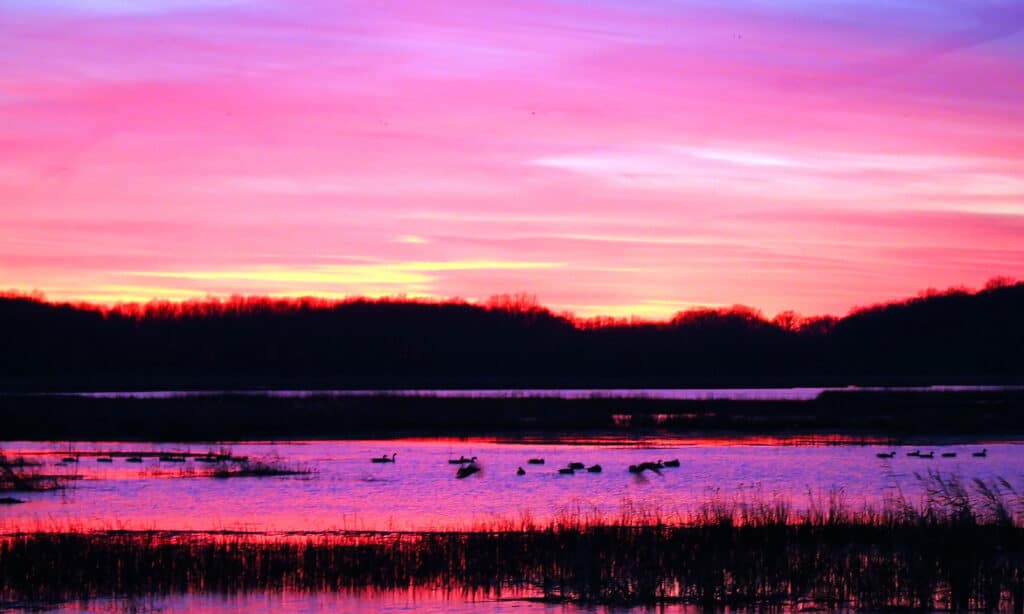
iStock.com/Edward Palm
The Delaware Bay originates from the Delaware River, one of the most vital saltwater estuaries in the United States. The estuary outlet covers approximately 782 square miles.
The state of Delaware borders the lower portion of Delaware Bay to the south and New Jersey to the north. Furthermore, the Bay opens up quite a bit before converging with the Atlantic ocean.
Coastal Stronghold
Known as being a coastal stronghold, Delaware Bay can help protect residents from rising sea levels. Over the next century, scientists believe sea levels could rise from 1 to 6 ft!
Rising waters can completely change the landscape of the existing residences and towns. As a result, residents of coastal counties will rely on coastal strongholds to keep the waters away.
Mudflats and Salt Marshes
The shores of the Bay are comprised mainly of mud flats and salt marshes. Along with the Delaware River, Delaware Bay is fed by numerous streams and rivers. The Christina River and St. Jones River help provide the Bay from the Delaware side.
Popular Place for Migratory Birds
Delaware Bay is a popular spot for migratory birds. In a single day, as many as 216,000 migratory birds will visit the bay. The most abundant species are the Semipalmated Sandpiper, Red Knot, Sanderlings, and Ruddy Turnstones.
More from A-Z Animals
The Delaware River is the longest river without dams east of the Mississippi!
The entire river serves as an interstate boundary. In other words, when you stand on one of the banks, you’ll always be looking across at a different state.
The immense river supports world-class trout fishery and river-based recreation. Economically, millions of people rely on the river to provide them with clean drinking water.
In addition, a wealth of wildlife also depends on the river to live. The working river is proud to be included in the National Wild and Scenic River system.
How long is the Delaware river? Read on to find out!
How Long Is the Delaware River?

vm2002/Shutterstock.com
The Delaware River is 330 miles long. Meanwhile, it’s only a little bit longer than the Hudson River, which is 315 miles long. The river serves as a major river on the Atlantic Coast of the United States.
Amazingly, the entire drainage area covers over 13,000 square miles. It’s eone of 19 “Great Waters” acknowledged by America’s Great Waters Coalition.
In addition, even though the river is large, it’s not the biggest in the area. Delaware is shorter than the Potomac (405 miles) and the Susquehanna Rivers (444 miles).
Where Does the Delaware River Start?

Corey B Stevens/Shutterstock.com
The Delaware River begins in the Catskill Mountains of New York. The river has 2 distinct branches.
Near Mount, Jefferson is where the Western branch of the river begins. Furthermore, the Eastern branch of the river also begins near Roxbury, located at Grand gorge.
Moving on, the Western and Eastern branches of the river merge in Hancock, New York. From there, they flow as 1 river down into the Delaware Bay.
As a result, the river flows through 5 States. The States include Pennsylvania, New York, Maryland, New Jersey, and Delaware. Pennsylvania is especially popular for its trout and bass fishing opportunities.
Where Does the Delaware River End?
The Delaware River ends when it enters the Atlantic Ocean. The river flows into the Atlantic Ocean right by Cape May in New Jersey. It also enters Cape Henlopen in Delaware.
How Deep Is the Delaware River?
The Delaware River is 113 ft deep in some parts. The deepest part of the river occurs at Big Eddy in Narrowsburg, New York. The depth of the river varies from one location to the next.
Regularly, the river has a depth of 4-6 feet along the shorelines. However, there’s a deep drop-off as you move away from the shore. Moving further out, the river reaches depths of 30 to 40 ft and beyond.
Deepening Project
The main transportation port for the Delaware River is a 103-mile stretch. The stretch occurs from Philadelphia and Camden to Delaware Bay. Fun fact; the large Delaware Bay isn’t the biggest bay in the world.
The main transportation port used to be a part of a decades-long deepening project. The project worked to change the river’s depth from 40 ft to 45 ft. Wrapping up in 2018, the project’s goal was able to help improve the route for shipping cargo.
Why Is the Delaware River So Famous?

Delaware is rich in lakes, rivers, and estuaries. What makes the Delaware river so famous?
The river is famous because George Washington crossed it on December 25th, 1776. As a general for the Continental Army, George Washington bravely led troops across the ice-filled river.
Moving forward, the journey was to aid in an attack against Hessian troops near Trenton. The crossing took place at Micani’s Ferry in Bucks County, Pennsylvania. The Delaware crossing cemented Washington’s role as a primary leader. Equally important, the river also helped shape the history of the States it runs through.
Delawares Main Tributaries
The Delaware River has over 200 tributary streams and creeks. There are around 14,000 miles of creeks and streams in the river watershed.
Each state has its major tributaries. The main tributaries in New York are the Neversink Mongaup Rivers and Callicoon Creek.
The Lackawaxen, Schuylkill, and Lehigh Rivers feed Delaware in Pennsylvania. Entering New Jersey, the main tributaries are the Cooper and Maurice Rivers, along with the Rancocas and Musconetcong Creek. The watersheds, streams, creeks, and rivers include Maurice River, Oldmans Creek, Salem river, and Valley Creek, to name a few.
Where Is the Delaware River Tidal?
The Delaware River is tidal from Trenton to Delaware Bay. From Trenton, New Jersey, to New York, the river is non-tidal. The 200-mile stretch of non-tidal waters is known for being exceptionally clean and high-quality.
Alternatively, the tidal portion of the river is also known as the Delaware estuary. It’s where the river’s freshwaters begin mixing with the ocean’s saltwater. The tidal change is around 6 ft in Delaware bay. In Trenton, New Jersey, the tidal changes around 10 ft.
Where Does the Delaware River Become Brackish?
The Delaware River is brackish in Wilmington, Delaware. In other words, the entire tidal portion of the river is estuarine.
Brackish waters are a mixture of salt and freshwater’s joining together. The salinity levels fluctuate. That’s why you’ll find saltwater in Delaware Bay. Alternatively, it’s primarily freshwater in Trenton, New Jersey.
Intriguing Delaware Bay Facts

iStock.com/Edward Palm
The Delaware Bay originates from the Delaware River, one of the most vital saltwater estuaries in the United States. The estuary outlet covers approximately 782 square miles.
The state of Delaware borders the lower portion of Delaware Bay to the south and New Jersey to the north. Furthermore, the Bay opens up quite a bit before converging with the Atlantic ocean.
Coastal Stronghold
Known as being a coastal stronghold, Delaware Bay can help protect residents from rising sea levels. Over the next century, scientists believe sea levels could rise from 1 to 6 ft!
Rising waters can completely change the landscape of the existing residences and towns. As a result, residents of coastal counties will rely on coastal strongholds to keep the waters away.
Mudflats and Salt Marshes
The shores of the Bay are comprised mainly of mud flats and salt marshes. Along with the Delaware River, Delaware Bay is fed by numerous streams and rivers. The Christina River and St. Jones River help provide the Bay from the Delaware side.
Popular Place for Migratory Birds
Delaware Bay is a popular spot for migratory birds. In a single day, as many as 216,000 migratory birds will visit the bay. The most abundant species are the Semipalmated Sandpiper, Red Knot, Sanderlings, and Ruddy Turnstones.

